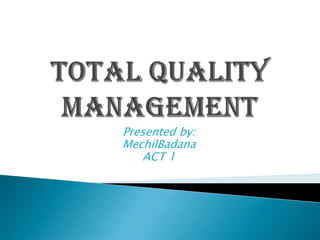
Totalqualitymanagement 091119001150-phpapp02
- 1. Total Quality Management Presented by: MechilBadana ACT 1
- 2. Total Quality Management, TQM, is a method by which management and employees can become involved in the continuous improvement of the production of goods and services. It is a combination of quality and management tools aimed at increasing business and reducing losses due to wasteful practices. Some of the companies who have implemented TQM include Ford Motor Company, Phillips Semiconductor, SGL Carbon, Motorola and Toyota Motor Company.1
- 3. TQM DefinedTQM is a management philosophy that seeks to integrate all organizational functions (marketing, finance, design, engineering, and production, customer service, etc.) to focus on meeting customer needs and organizational objectives
- 6. Reducing development cycle times
- 7. Just In Time/Demand Flow Manufacturing
- 9. Reducing product and service costs
- 10. Systems to facilitate improvement
- 11. Line Management ownership
- 12. Employee involvement and empowerment Recognition and celebration
- 13. Challenging quantified goals and benchmarking
- 14. Focus on processes / improvement plans
- 16. Management Commitment Plan (drive, direct) Do (deploy, support, participate) Check (review) Act (recognize, communicate, revise) Employee Empowerment Training Suggestion scheme Measurement and recognition Excellence teams Principles of TQM
- 17. Customer Focus Supplier partnership Service relationship with internal customers Never compromise quality Customer driven standards
- 18. TQM is mainly concerned with continuous improvement in all work, from high level strategic planning and decision-making, to detailed execution of work elements on the shop floor. It stems from the belief that mistakes can be avoided and defects can be prevented. It leads to continuously improving results, in all aspects of work, as a result of continuously improving capabilities, people, processes, technology and machine capabilities. The Concept of Continuous Improvement by TQM
- 19. Preventing mistakes (defects) from occurring (Mistake - proofing or Poka-Yoke). Where mistakes can't be absolutely prevented, detecting them early to prevent them being passed down the value added chain (Inspection at source or by the next operation). Where mistakes recur, stopping production until the process can be corrected, to prevent the production of more defects. (Stop in time). There are three major mechanisms of prevention:
- 20. A preliminary step in TQM implementation is to assess the organization's current reality. Relevant preconditions have to do with the organization's history, its current needs, precipitating events leading to TQM, and the existing employee quality of working life. If the current reality does not include important preconditions, TQM implementation should be delayed until the organization is in a state in which TQM is likely to succeed. Implementation Principles and Processes
- 21. Beckhard and Pritchard (1992) have outlined the basic steps in managing a transition to a new system such as TQM: identifying tasks to be done, creating necessary management structures, developing strategies for building commitment, designing mechanisms to communicate the change, and assigning resources. Steps in Managing the Transition
- 22. TQM encoureges participation amongst shop floor workers and managers. There is no single theoretical formalization of total quality, but Deming, Juran and Ishikawa provide the core assumptions, as a "...discipline and philosophy of management which institutionalizes planned and continuous... improvement ... and assumes that quality is the outcome of all activities that take place within an organization; that all functions and all employees have to participate in the improvement process; that organizations need both quality systems and a quality culture.". Conclusion
- 23. KhurramHashmi is an avionics engineer currently working in the Pakistan Air Force Academy. Mr. Hashmi has a inclination in electronics and Quality Management. About The Author
- 24. 1. Gilbert, G. (1992). Quality Improvement in a Defense Organization. Public Productivity and Management Review, 16(1), 65-75.2. Hyde, A. (1992). The Proverbs of Total Quality Management: Recharting the Path to Quality Improvement in the Public Sector. Public Productivity and Management Review, 16(1), 25-37.3. Martin, L. (1993). "Total Quality Management in the Public Sector," National Productivity Review, 10, 195-213. 4. Swiss, J. (1992). Adapting TQM to Government. Public Administration Review, 52, 356-362. 5. Tichey, N. (1983). Managing Strategic Change. New York: John Wiley & Sons. 6. Hill Stephen, 1991. "Why Quality Circles failed but Total Quality management might succeed." British journal of industrial relations, 29(4), 541-568.7. Ishikawa, K, 1985.What is Total Quality Control? The Japanese way. Englewood Cliffs, New Jersey, Prentice- Hall.8. Smith, AK, 1993. Total Quality Management in the Public sector. Quality Progress, June 1993, 45-48. Footnotes And References